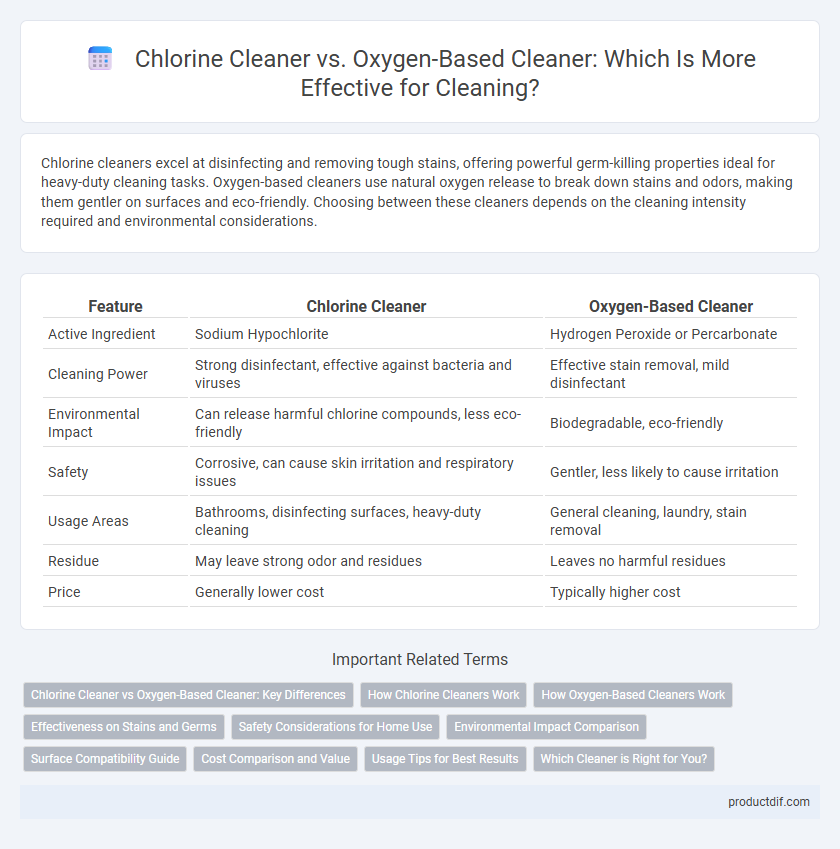Chlorine cleaners excel at disinfecting and removing tough stains, offering powerful germ-killing properties ideal for heavy-duty cleaning tasks. Oxygen-based cleaners use natural oxygen release to break down stains and odors, making them gentler on surfaces and eco-friendly. Choosing between these cleaners depends on the cleaning intensity required and environmental considerations.
Table of Comparison
| Feature | Chlorine Cleaner | Oxygen-Based Cleaner |
|---|---|---|
| Active Ingredient | Sodium Hypochlorite | Hydrogen Peroxide or Percarbonate |
| Cleaning Power | Strong disinfectant, effective against bacteria and viruses | Effective stain removal, mild disinfectant |
| Environmental Impact | Can release harmful chlorine compounds, less eco-friendly | Biodegradable, eco-friendly |
| Safety | Corrosive, can cause skin irritation and respiratory issues | Gentler, less likely to cause irritation |
| Usage Areas | Bathrooms, disinfecting surfaces, heavy-duty cleaning | General cleaning, laundry, stain removal |
| Residue | May leave strong odor and residues | Leaves no harmful residues |
| Price | Generally lower cost | Typically higher cost |
Chlorine Cleaner vs Oxygen-Based Cleaner: Key Differences
Chlorine cleaners utilize sodium hypochlorite as a powerful disinfectant effective against bacteria, viruses, and mold, making them ideal for sanitizing surfaces in healthcare and sanitation settings. Oxygen-based cleaners rely on hydrogen peroxide or percarbonate compounds that break down organic stains through oxidation, offering a safer, eco-friendly alternative with minimal residue. The primary differences lie in chlorine cleaners' strong bleaching and disinfectant properties versus oxygen-based cleaners' stain removal capabilities and environmental safety.
How Chlorine Cleaners Work
Chlorine cleaners work by releasing chlorine molecules that break down and oxidize organic stains, bacteria, and viruses on surfaces, making them highly effective for disinfection and whitening tasks. These cleaners target microbial cell walls and pigments, causing irreversible damage that leads to the elimination of pathogens and tough grime. Their fast-acting chemical reaction makes them popular in healthcare and sanitation environments where rapid sterilization is essential.
How Oxygen-Based Cleaners Work
Oxygen-based cleaners utilize sodium percarbonate or hydrogen peroxide compounds that release oxygen molecules when mixed with water, effectively breaking down stains and organic matter at a molecular level. This oxygen release targets and lifts dirt, grease, and grime, making it a powerful and environmentally-friendly alternative to chlorine cleaners. The active oxygen also acts as a natural disinfectant, promoting cleaner surfaces without the harsh chemical residue associated with chlorine-based products.
Effectiveness on Stains and Germs
Chlorine cleaners provide powerful disinfection and stain removal, especially effective against mold, mildew, and tough biofilm due to their strong oxidizing properties. Oxygen-based cleaners use hydrogen peroxide or similar compounds to break down organic stains and odors while offering safer, eco-friendly germ-killing effects on common household bacteria. For heavy-duty sanitizing and deep stain removal, chlorine cleaners excel, whereas oxygen-based cleaners are preferred for routine cleaning with minimized chemical impact.
Safety Considerations for Home Use
Chlorine cleaners release strong fumes that can cause respiratory irritation and should be used in well-ventilated areas, avoiding mixing with ammonia or acids to prevent toxic gas formation. Oxygen-based cleaners, containing hydrogen peroxide or sodium percarbonate, offer safer alternatives with biodegradable ingredients and less harmful vapors, reducing risks for children and pets. Proper storage and following product instructions remain essential to maintain household safety regardless of cleaner type.
Environmental Impact Comparison
Chlorine cleaners release harmful byproducts such as dioxins and chlorinated compounds, which contribute to water pollution and pose risks to aquatic life. Oxygen-based cleaners break down into water and oxygen, offering a biodegradable and eco-friendly alternative with minimal environmental toxicity. Choosing oxygen-based cleaners significantly reduces the ecological footprint associated with household and industrial cleaning practices.
Surface Compatibility Guide
Chlorine cleaners excel in disinfecting hard, non-porous surfaces like tiles, stainless steel, and countertops but may cause discoloration or damage to fabrics, wood, and certain plastics. Oxygen-based cleaners offer a gentler option suitable for a wider range of surfaces, including delicate fabrics, painted surfaces, and natural stone, without the risk of bleaching or corrosion. Choosing the right cleaner requires assessing surface type and sensitivity to ensure both effective cleaning and preservation of material integrity.
Cost Comparison and Value
Chlorine cleaners typically offer lower upfront costs and strong disinfecting power, making them cost-effective for heavy-duty cleaning tasks. Oxygen-based cleaners, while often more expensive initially, provide a safer environmental profile and versatility across surfaces, delivering greater long-term value. Evaluating total cost of ownership, including safety equipment and surface compatibility, reveals oxygen-based cleaners as a more sustainable investment despite higher initial prices.
Usage Tips for Best Results
Chlorine cleaners excel in disinfecting hard surfaces and removing tough stains, so use them in well-ventilated areas and avoid mixing with ammonia or acids to prevent harmful fumes. Oxygen-based cleaners are ideal for fabrics and carpets, offering effective stain removal without harsh odors, and performing best when applied on damp surfaces and allowed to sit before rinsing. Always follow product instructions and wear gloves to protect skin during use for optimal safety and cleaning performance.
Which Cleaner is Right for You?
Chlorine cleaners provide powerful disinfecting and stain removal, making them ideal for heavy-duty cleaning tasks and germ-prone areas. Oxygen-based cleaners offer a gentle yet effective solution, breaking down organic stains and residues without harsh fumes or environmental impact. Choosing the right cleaner depends on the surface sensitivity, desired cleaning strength, and safety preferences.
Chlorine Cleaner vs Oxygen-Based Cleaner Infographic

 productdif.com
productdif.com